Flexible and Wearable Strain–Temperature Sensors Based on Chitosan/Ink Sponges
Abstract
1. Introduction
2. Results and Discussion
2.1. Preparation of CS-Ink Sponge
2.2. Characterization of CS-Ink Sponge
2.3. Photothermal Property of CS-Ink Sponge
2.4. Application of CS-Ink Sponge as Strain Sensor
2.5. Application of CS-Ink as Temperature Detection Sensor
3. Materials and Methods
3.1. Materials
3.2. Preparation of Chitosan-Ink Carbon Nanoparticles Sponge
3.3. Characterization Methods
3.4. Mechanical Properties
3.5. Porosity
3.6. Electrical Conductivity
3.7. Photothermal Performance
3.8. The Application of CS-Ink Sponge as a Strain Sensor
3.9. Temperature Monitoring
4. Conclusions
Author Contributions
Funding
Institutional Review Board Statement
Informed Consent Statement
Data Availability Statement
Acknowledgments
Conflicts of Interest
Sample Availability
References
- Chen, J.; Zhu, Y.; Chang, X.; Pan, D.; Song, G.; Guo, Z.; Naik, N. Recent progress in essential functions of soft electronic skin. Adv. Funct. Mater. 2021, 31, 2104686. [Google Scholar] [CrossRef]
- Wang, J.; Lu, C.; Zhang, K. Textile-based strain sensor for human motion detection. Energy Environ. Mater. 2020, 3, 80–100. [Google Scholar] [CrossRef]
- Zang, Y.; Zhang, F.; Di, C.-A.; Zhu, D. Advances of flexible pressure sensors toward artificial intelligence and health care applications. Mater. Horiz. 2015, 2, 140–156. [Google Scholar] [CrossRef]
- Zhou, Y.; Shen, M.; Cui, X.; Shao, Y.; Li, L.; Zhang, Y. Triboelectric nanogenerator based self-powered sensor for artificial intelligence. Nano Energy 2021, 84, 105887. [Google Scholar] [CrossRef]
- Sun, H.; Bu, Y.; Liu, H.; Wang, J.; Yang, W.; Li, Q.; Guo, Z.; Liu, C.; Shen, C. Superhydrophobic conductive rubber band with synergistic dual conductive layer for wide-range sensitive strain sensor. Sci. Bull. 2022, 67, 1669–1678. [Google Scholar] [CrossRef]
- Li, M.; Chen, J.; Zhong, W.; Luo, M.; Wang, W.; Qing, X.; Lu, Y.; Liu, Q.; Liu, K.; Wang, Y. Large-area, wearable, self-powered pressure–temperature sensor based on 3D thermoelectric spacer fabric. ACS Sens. 2020, 5, 2545–2554. [Google Scholar] [CrossRef]
- Sang, M.; Kang, K.; Zhang, Y.; Zhang, H.; Kim, K.; Cho, M.; Shin, J.; Hong, J.H.; Kim, T.; Lee, S.K. Ultrahigh sensitive Au-doped silicon nanomembrane based wearable sensor arrays for continuous skin temperature monitoring with high precision. Adv. Mater. 2022, 34, 2105865. [Google Scholar] [CrossRef]
- Cuana, R.; Nasution, T.; Agusnar, H.; Susilowati, A.; Lubis, N.; Pradana, I. Humidity Detection Based on Chitosan/PEO Film Sensor. J. Phys. Conf. Ser. 2023, 2421, 012038. [Google Scholar] [CrossRef]
- Choi, S.-J.; Kim, I.-D. Recent developments in 2D nanomaterials for chemiresistive-type gas sensors. Electron. Mater. Lett. 2018, 14, 221–260. [Google Scholar] [CrossRef]
- Park, H.; Kim, W.; Lee, S.W.; Park, J.; Lee, G.; Yoon, D.S.; Lee, W.; Park, J. Flexible and disposable paper-based gas sensor using reduced graphene oxide/chitosan composite. J. Mater. Sci. Technol. 2022, 101, 165–172. [Google Scholar] [CrossRef]
- Shen, Z.; Zhang, Z.; Zhang, N.; Li, J.; Zhou, P.; Hu, F.; Rong, Y.; Lu, B.; Gu, G. High-Stretchability, Ultralow-Hysteresis ConductingPolymer Hydrogel Strain Sensors for Soft Machines. Adv. Mater. 2022, 34, 2203650. [Google Scholar] [CrossRef] [PubMed]
- Xu, Z.; Zhang, D.; Liu, X.; Yang, Y.; Wang, X.; Xue, Q. Self-powered multifunctional monitoring and analysis system based on dual-triboelectric nanogenerator and chitosan/activated carbon film humidity sensor. Nano Energy 2022, 94, 106881. [Google Scholar] [CrossRef]
- Liu, H.; Xu, T.; Cai, C.; Liu, K.; Liu, W.; Zhang, M.; Du, H.; Si, C.; Zhang, K. Multifunctional superelastic, superhydrophilic, and ultralight nanocellulose-based composite carbon aerogels for compressive supercapacitor and strain sensor. Adv. Funct. Mater. 2022, 32, 2113082. [Google Scholar] [CrossRef]
- Zeng, R.; Lu, S.; Qi, C.; Jin, L.; Xu, J.; Dong, Z.; Lei, C. Polyacrylamide/carboxymethyl chitosan double-network hydrogels with high conductivity and mechanical toughness for flexible sensors. J. Appl. Polym. Sci. 2022, 139, 51993. [Google Scholar] [CrossRef]
- Quan, L.; Tie, J.; Wang, Y.; Mao, Z.; Zhang, L.; Zhong, Y.; Sui, X.; Feng, X.; Xu, H. Mussel-inspired chitosan-based hydrogel sensor with pH-responsive and adjustable adhesion, toughness and self-healing capability. Polym. Adv. Technol. 2022, 33, 1867–1880. [Google Scholar] [CrossRef]
- Cai, J.; Du, M.; Li, Z. Flexible temperature sensors constructed with fiber materials. Adv. Mater. Technol. 2022, 7, 2101182. [Google Scholar] [CrossRef]
- Wei, L.; Wu, Z.; Tang, S.; Qin, X.; Xiong, Y.; Li, J.; Ruiz-Hitzky, E.; Wang, X. Tracheid-inspired nanoarchitectured carbon-based aerogels with ultra-compressibility for wearable piezoresistive sensors. Carbon 2023, 203, 386–396. [Google Scholar] [CrossRef]
- Miyamoto, A.; Lee, S.; Cooray, N.F.; Lee, S.; Mori, M.; Matsuhisa, N.; Jin, H.; Yoda, L.; Yokota, T.; Itoh, A. Inflammation-free, gas-permeable, lightweight, stretchable on-skin electronics with nanomeshes. Nat. Nanotechnol. 2017, 12, 907–913. [Google Scholar] [CrossRef]
- He, Y.; Zhou, M.; Mahmoud, M.; Lu, X.; He, G.; Zhang, L.; Huang, M.; Elnaggar, A.Y.; Lei, Q.; Liu, H. Multifunctional wearable strain/pressure sensor based on conductive carbon nanotubes/silk nonwoven fabric with high durability and low detection limit. Adv. Compos. Hybrid Mater. 2022, 5, 1939–1950. [Google Scholar] [CrossRef]
- Liu, C.; Tan, Q.; Deng, Y.; Ye, P.; Kong, L.; Ma, X.; Xu, L.; Xu, Y.; Qiang, Q.; Chen, W. Highly sensitive and stable 3D flexible pressure sensor based on carbon black and multi-walled carbon nanotubes prepared by hydrothermal method. Compos. Commun. 2022, 32, 101178. [Google Scholar] [CrossRef]
- Chen, Y.; Wang, L.; Wu, Z.; Luo, J.; Li, B.; Huang, X.; Xue, H.; Gao, J. Super-hydrophobic, durable and cost-effective carbon black/rubber composites for high performance strain sensors. Compos. Part B Eng. 2019, 176, 107358. [Google Scholar] [CrossRef]
- Araki, T.; Uemura, T.; Yoshimoto, S.; Takemoto, A.; Noda, Y.; Izumi, S.; Sekitani, T. Wireless monitoring using a stretchable and transparent sensor sheet containing metal nanowires. Adv. Mater. 2020, 32, 1902684. [Google Scholar] [CrossRef] [PubMed]
- Chen, T.; Liu, Z.; Zhao, G.; Qin, Z.; Zheng, P.; Aladejana, J.T.; Tang, Z.; Weng, M.; Peng, X.; Chang, J. Piezoresistive Sensor Containing Lamellar MXene-Plant Fiber Sponge Obtained with Aqueous MXene Ink. ACS Appl. Mater. Interfaces 2022, 14, 51361–51372. [Google Scholar] [CrossRef]
- An, K.H.; Jeong, S.Y.; Hwang, H.R.; Lee, Y.H. Enhanced sensitivity of a gas sensor incorporating single-walled carbon nanotube–polypyrrole nanocomposites. Adv. Mater. 2004, 16, 1005–1009. [Google Scholar] [CrossRef]
- Lin, J.; Zhou, P.; Chen, Q.; Zhang, W.; Luo, Z.; Chen, L. Reprogrammable, light-driven and sensing actuators based on Chinese ink composite: A synergetic use of shape-memory and self-healing strategies. Sens. Actuators B Chem. 2022, 362, 131776. [Google Scholar] [CrossRef]
- Wei, S.; Fang, X.; Yang, J.; Cao, X.; Pintus, V.; Schreiner, M.; Song, G. Identification of the materials used in an Eastern Jin Chinese ink stick. J. Cult. Herit. 2012, 13, 448–452. [Google Scholar] [CrossRef]
- Swider, J.R.; Hackley, V.A.; Winter, J. Characterization of Chinese ink in size and surface. J. Cult. Herit. 2003, 4, 175–186. [Google Scholar] [CrossRef]
- Zhang, X.-F.; Wang, Z.; Song, L.; Feng, Y.; Yao, J. Chinese ink enabled wood evaporator for continuous water desalination. Desalination 2020, 496, 114727. [Google Scholar] [CrossRef]
- Chen, D.; Chen, C.; Huang, C.; Chen, T.; Liu, Z. Injectable hydrogel for NIR-II photo-thermal tumor therapy and dihydroartemisinin-mediated chemodynamic therapy. Front. Chem. 2020, 8, 251. [Google Scholar] [CrossRef]
- Cao, X.; Liu, H.; Cai, J.; Chen, L.; Yang, X.; Liu, M. Chinese ink coated melamine foam with Joule heating and photothermal effect for strain sensor and seawater desalination. Compos. Part A Appl. Sci. Manuf. 2021, 149, 106535. [Google Scholar] [CrossRef]
- Liu, B.; Zhou, Y.; Chen, L.; Feng, Y.; Liu, M. High-performance sensors based on chinese ink and water-based glue for detection of strain, temperature, and humidity. ACS Sustain. Chem. Eng. 2022, 10, 1847–1856. [Google Scholar] [CrossRef]
- Wang, S.; Cao, Y.; Zhang, Q.; Peng, H.; Liang, L.; Li, Q.; Shen, S.; Tuerdi, A.; Xu, Y.; Cai, S. New application of old material: Chinese traditional ink for photothermal therapy of metastatic lymph nodes. ACS Omega 2017, 2, 5170–5178. [Google Scholar] [CrossRef] [PubMed]
- Zhou, L.; Sun, L.; Fu, P.; Yang, C.; Yuan, Y. Carbon nanoparticles of Chinese ink-wrapped natural loofah sponge: A low-cost three-dimensional electrode for high-performance microbial energy harvesting. J. Mater. Chem. A 2017, 5, 14741–14747. [Google Scholar] [CrossRef]
- Zhang, S.; Zhang, F.; Zhang, Z.; Li, G.; Fu, H.; Huang, J.; Wang, Y.; Lei, Z.; Qian, X.; Lai, Y. An electroless nickel plating fabric coated with photothermal Chinese ink for powerful passive anti-icing/icephobic and fast active deicing. Chem. Eng. J. 2022, 450, 138328. [Google Scholar] [CrossRef]
- Ong, S.-Y.; Wu, J.; Moochhala, S.M.; Tan, M.-H.; Lu, J. Development of a chitosan-based wound dressing with improved hemostatic and antimicrobial properties. Biomaterials 2008, 29, 4323–4332. [Google Scholar] [CrossRef]
- Hu, Z.; Zhang, D.-Y.; Lu, S.-T.; Li, P.-W.; Li, S.-D. Chitosan-based composite materials for prospective hemostatic applications. Mar. Drugs 2018, 16, 273. [Google Scholar] [CrossRef]
- Li, Q.; Dunn, E.; Grandmaison, E.; Goosen, M.F. Applications and properties of chitosan. In Applications of Chitin and Chitosan; CRC Press: Boca Raton, FL, USA, 2020; pp. 3–29. [Google Scholar]
- Zheng, H.; Chen, G.; Gan, L.; Liu, J.; Lin, L. Iron-Adjustable Compressible Elastic Chitosan-Derived Carbon Aerogel with Wide-Range Linear Sensitivity and Super Sensing Performances for Wearable Piezoresistive Sensors. ACS Sustain. Chem. Eng. 2022, 10, 10604–10614. [Google Scholar] [CrossRef]
- Wu, J.; Li, H.; Lai, X.; Chen, Z.; Zeng, X. Conductive and superhydrophobic F-rGO@ CNTs/chitosan aerogel for piezoresistive pressure sensor. Chem. Eng. J. 2020, 386, 123998. [Google Scholar] [CrossRef]
- Lawrie, G.; Keen, I.; Drew, B.; Chandler-Temple, A.; Rintoul, L.; Fredericks, P.; Grøndahl, L. Interactions between alginate and chitosan biopolymers characterized using FTIR and XPS. Biomacromolecules 2007, 8, 2533–2541. [Google Scholar] [CrossRef]
- Nagyte, V.; Kelly, D.J.; Felten, A.; Picardi, G.; Shin, Y.; Alieva, A.; Worsley, R.E.; Parvez, K.; Dehm, S.; Krupke, R. Raman fingerprints of graphene produced by anodic electrochemical exfoliation. Nano Lett. 2020, 20, 3411–3419. [Google Scholar] [CrossRef]
- Zhang, Y.; Xue, C.; Xue, Y.; Gao, R.; Zhang, X. Determination of the degree of deacetylation of chitin and chitosan by X-ray powder diffraction. Carbohydr. Res. 2005, 340, 1914–1917. [Google Scholar] [CrossRef] [PubMed]
- Zhang, Y.; Chen, K.; Li, Y.; Lan, J.; Yan, B.; Shi, L.; Ran, R. High-strength, self-healable, temperature-sensitive, MXene-containing composite hydrogel as a smart compression sensor. ACS Appl. Mater. Interfaces 2019, 11, 47350–47357. [Google Scholar] [CrossRef] [PubMed]
- Wang, Q.; Huang, X.; Han, F.; Wu, Y.; Wang, L.; Dai, H.; Song, P.; Tang, L.; Gao, J. Superhydrophobic, biocompatible and durable nanofiber composite with an asymmetric structure for anisotropic strain sensing and body motion detection. Chem. Eng. J. 2022, 450, 137899. [Google Scholar] [CrossRef]
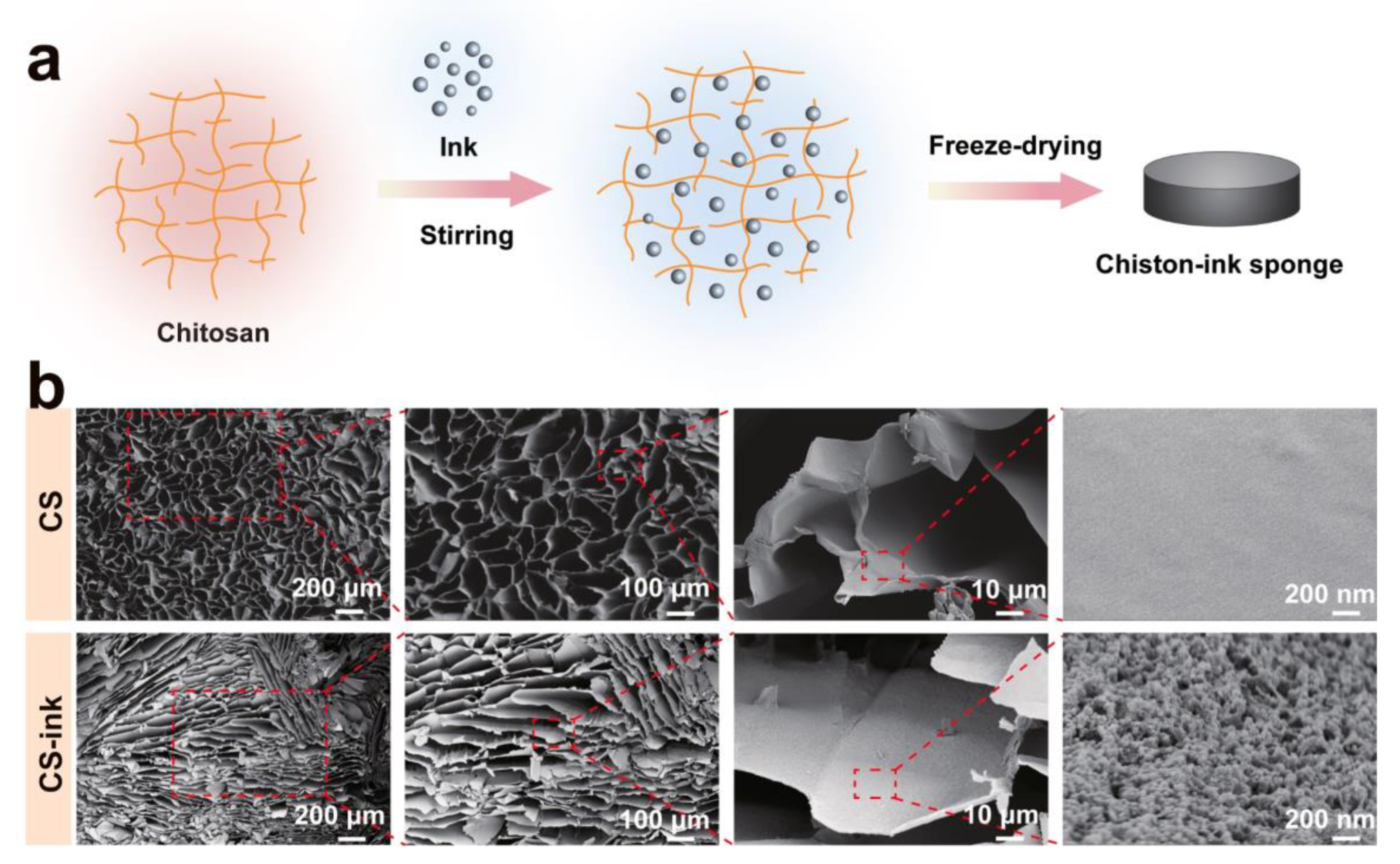
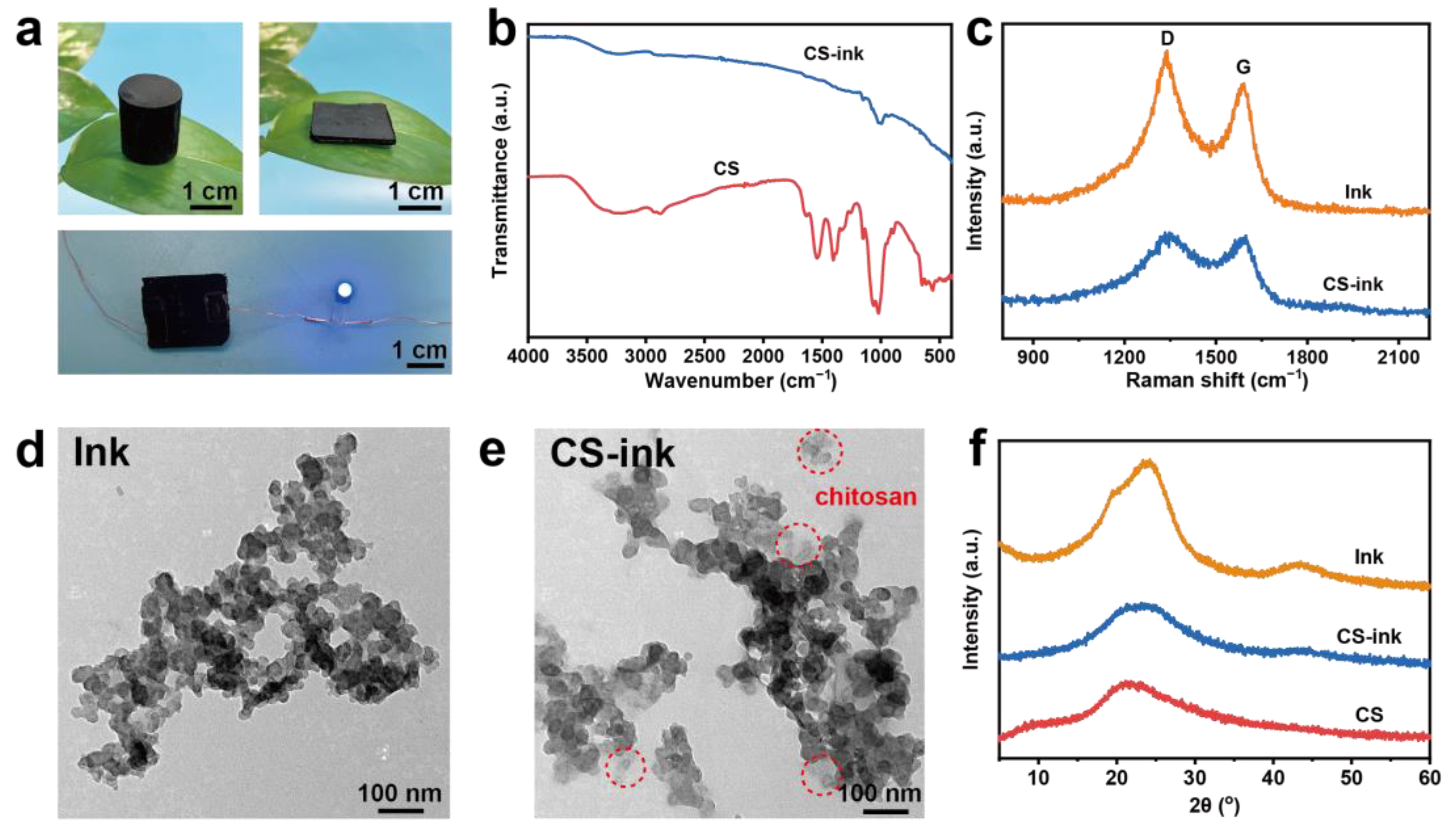
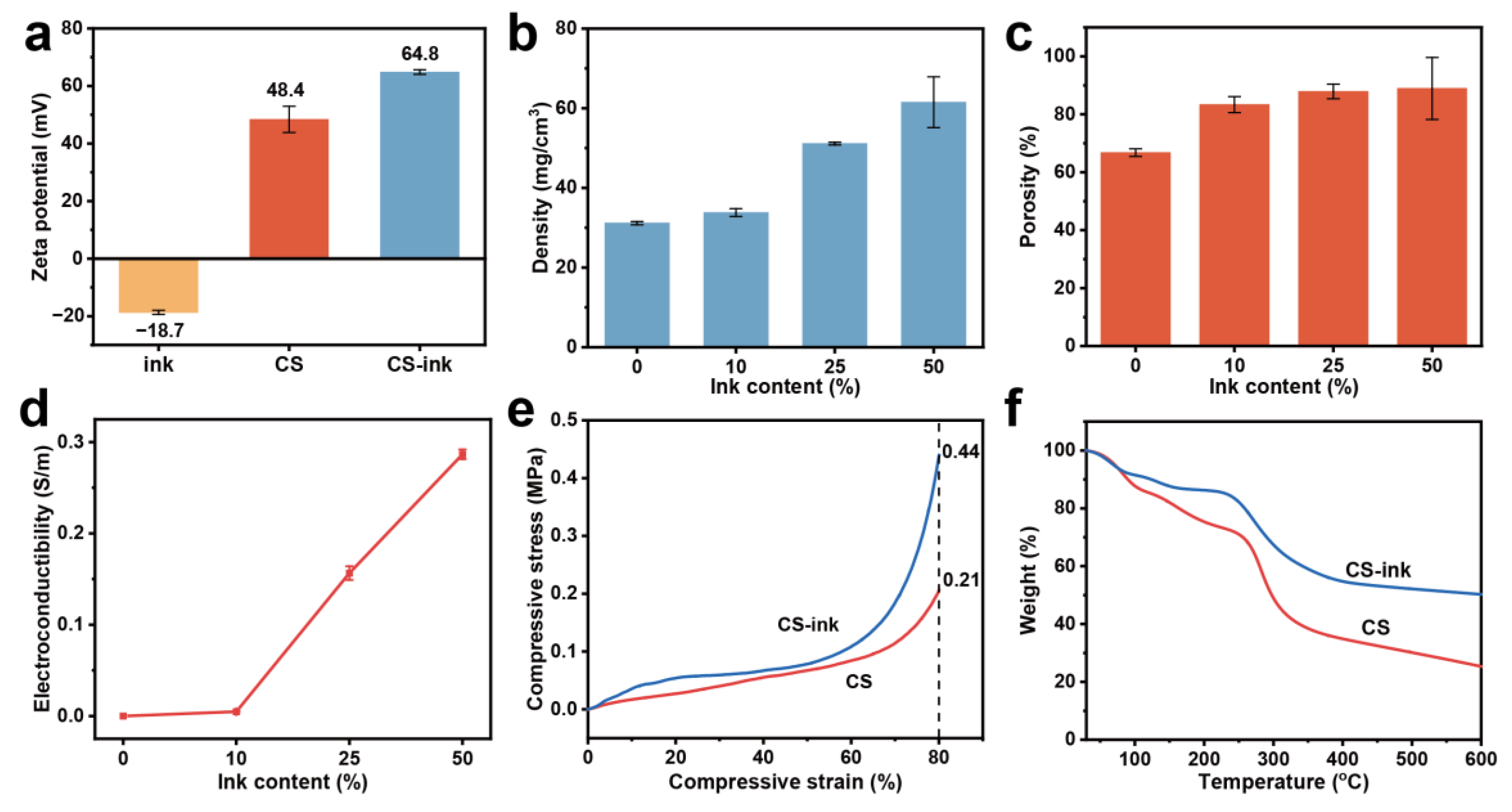
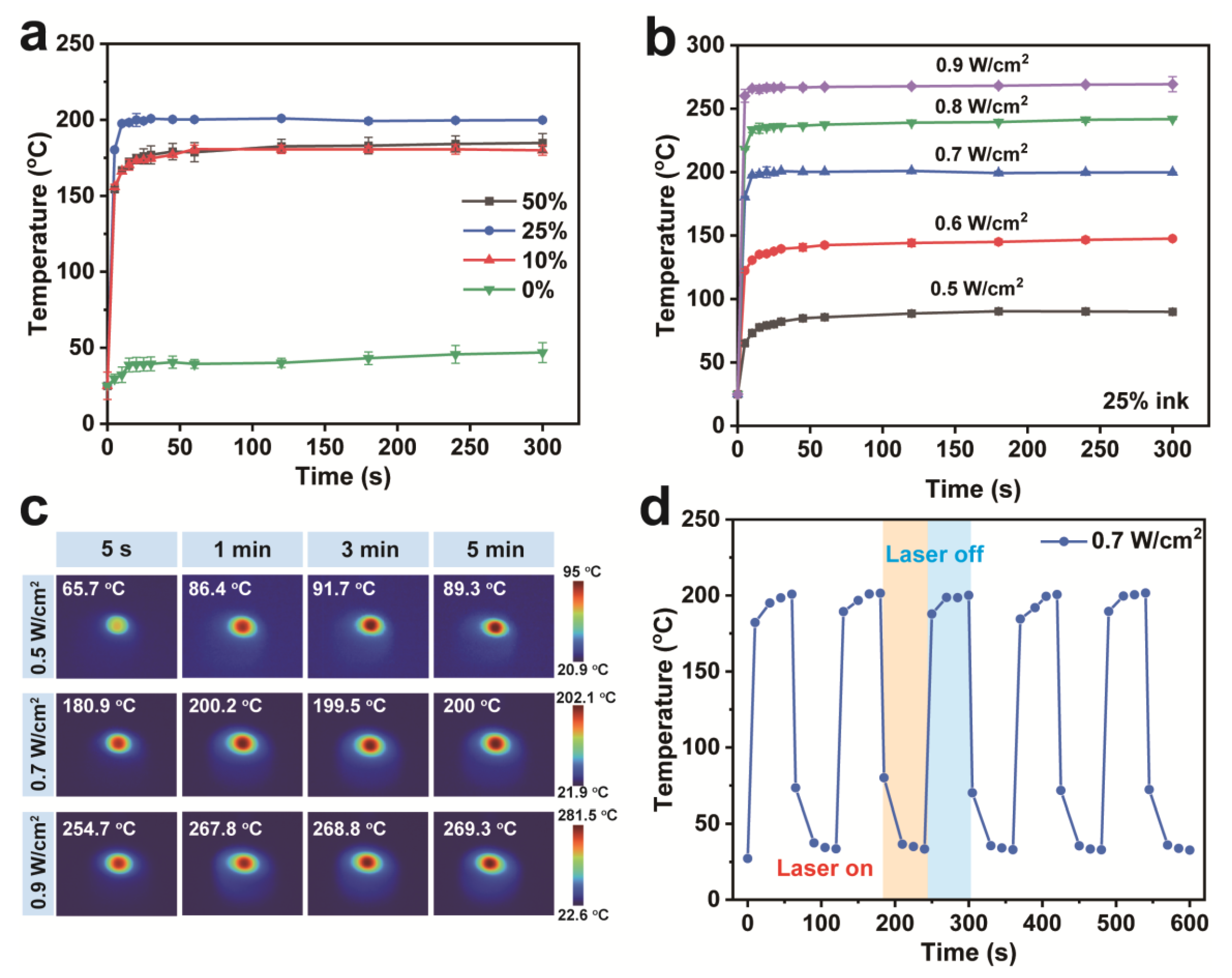
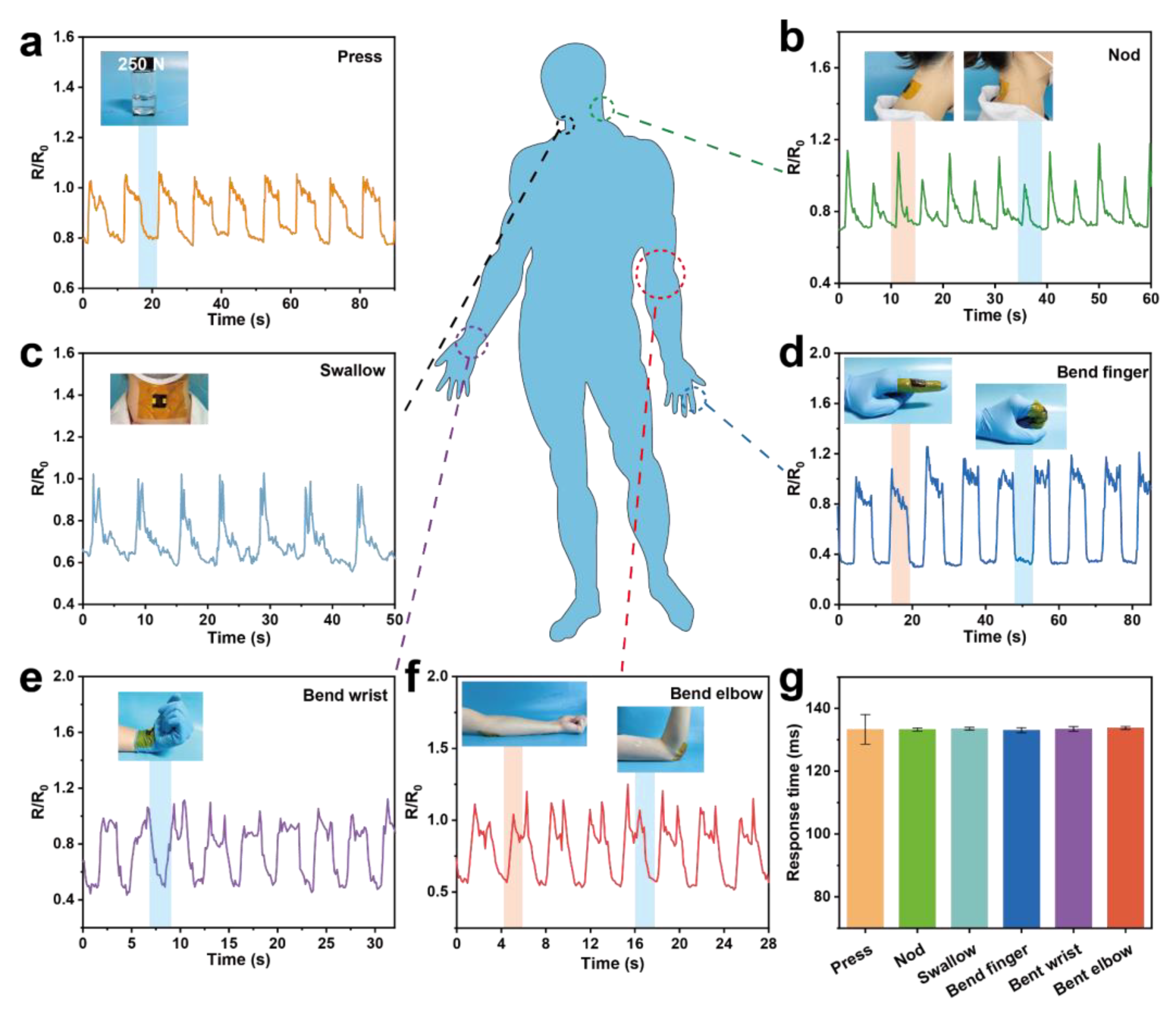

Disclaimer/Publisher’s Note: The statements, opinions and data contained in all publications are solely those of the individual author(s) and contributor(s) and not of MDPI and/or the editor(s). MDPI and/or the editor(s) disclaim responsibility for any injury to people or property resulting from any ideas, methods, instructions or products referred to in the content. |
© 2023 by the authors. Licensee MDPI, Basel, Switzerland. This article is an open access article distributed under the terms and conditions of the Creative Commons Attribution (CC BY) license (https://creativecommons.org/licenses/by/4.0/).
Share and Cite
Lin, X.; Wu, F.; He, Y.; Liu, M. Flexible and Wearable Strain–Temperature Sensors Based on Chitosan/Ink Sponges. Molecules 2023, 28, 4083. https://doi.org/10.3390/molecules28104083
Lin X, Wu F, He Y, Liu M. Flexible and Wearable Strain–Temperature Sensors Based on Chitosan/Ink Sponges. Molecules. 2023; 28(10):4083. https://doi.org/10.3390/molecules28104083
Chicago/Turabian StyleLin, Xiaoying, Feng Wu, Yunqing He, and Mingxian Liu. 2023. "Flexible and Wearable Strain–Temperature Sensors Based on Chitosan/Ink Sponges" Molecules 28, no. 10: 4083. https://doi.org/10.3390/molecules28104083
APA StyleLin, X., Wu, F., He, Y., & Liu, M. (2023). Flexible and Wearable Strain–Temperature Sensors Based on Chitosan/Ink Sponges. Molecules, 28(10), 4083. https://doi.org/10.3390/molecules28104083




